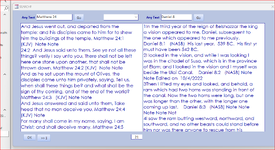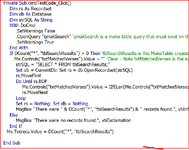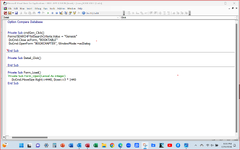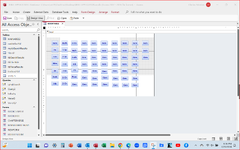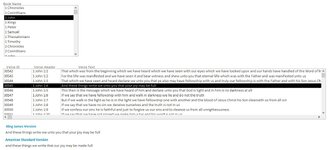Excel's VBA FIND method easily finds multiple records and copies them to another sheet. However, for me, trying to use this same code to do the
same thing with Acess's VBA code and a table is a different story. I know there is a difference between a sheet and an Access db table. And I know
won't recognize some oof the following code lines
I'm sure there has to be many cases where an Excel sheet gets so large that it facilitates porting the Excel application to Access's database based application
Such is my case. The main data Sheet has 31.103 rows and Excel stops responding at times. This is unacceptable for me. It has to work right every time.
Please take a look at this FIND method. Granted, it's long, but I' d really appreciate somone's help in moving this to Access.
I am not having any luck with trying to do the same thing with an Access Query. (The SQL copy Query to Table solution causes multiple conflicts and seems inefficient)
same thing with Acess's VBA code and a table is a different story. I know there is a difference between a sheet and an Access db table. And I know
won't recognize some oof the following code lines
I'm sure there has to be many cases where an Excel sheet gets so large that it facilitates porting the Excel application to Access's database based application
Such is my case. The main data Sheet has 31.103 rows and Excel stops responding at times. This is unacceptable for me. It has to work right every time.
Please take a look at this FIND method. Granted, it's long, but I' d really appreciate somone's help in moving this to Access.
I am not having any luck with trying to do the same thing with an Access Query. (The SQL copy Query to Table solution causes multiple conflicts and seems inefficient)
Code:
CORRECT EXCEL VBA FIND CODE
Private Sub cmdFIND_Click()
Sheets("MAINARES2").UsedRange.ClearContents
Dim lastrow, lastrow2 As Integer, X As String, c As Range, rw As Long, firstAddress As Variant, rowno As Variant, RownoA As Variant
X = MAINWINDOW2.TextBox11.Value
With Worksheets("Sheet2").Range("E1:E31103")
Set c = .FIND(X, LookIn:=xlValues, LookAt:=xlPart, MatchCase:=False, SearchFormat:=False)
If Not c Is Nothing Then
rw = 1
firstAddress = c.Address
Do
Worksheets("Sheet2").Select
c.Select
Range(Cells(c.Row, 2), Cells(c.Row, 7)).Copy Destination:=Sheets("MAINARES2").Range("B" & rw)
rw = rw + 1
Set c = .FindNext(c)
Loop While Not c Is Nothing And c.Address <> firstAddress
lastrow = Sheets("MAINARES2").Range("B" & rows.count).End(xlUp).Row
If lastrow = 1 Then
Range(Cells(c.Row + 7, 2), Cells(c.Row, 7)).Copy Destination:=Sheets("MAINARES2").Range("B" & rw)
Else
End If
Else
MsgBox "value not found"
End If
End With
rowno = Sheets("MAINARES2").Range("B2").End(xlDown).Row
Sheets("MAINARES2").Range("H1").Value = rowno 'total rows found in search
Sheets("MAINARES2").Range("I1").Value = X 'value to find, i.e.,, "last days"
End Sub
I apoligize for a lengthy post - I don't like them - but I cannot explain my dilemma and have people understand with less words and code.
If anyone with both Excel and Access build experience could help me, I'd really appreciate it vey much.
cr
